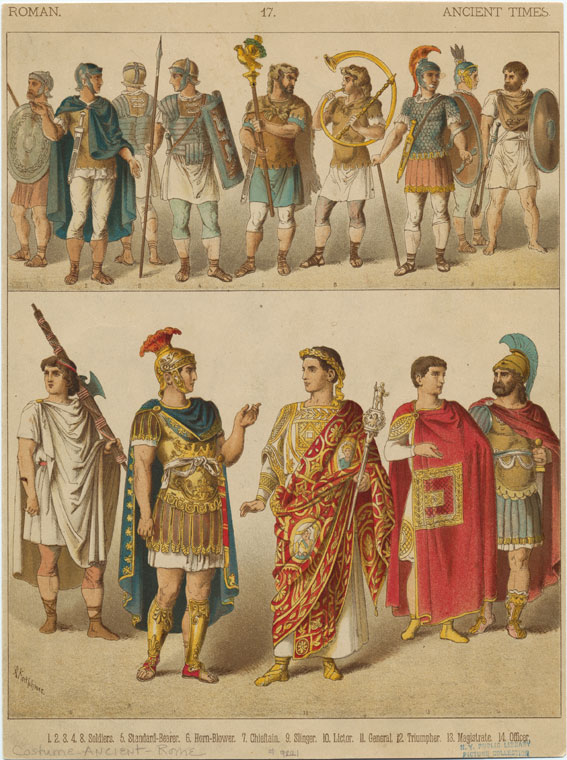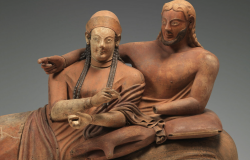In our ongoing series about the Ancient Romans, to commemorate the anniversary of the death of the first Roman Emperor, Augustus, in 14AD, we find out how the Ancient Romans dressed.
You can read part one, "The Romans: What They Ate" here; part two, "The Romans: Marriage and Weddings" here; part three, "The Romans: Top 5 Emperors" here.
The idea of 'fare una bella figura' and looking good is important to Italians. The concept could well have its roots in ancient times because what Romans wore was an indicator of their social standing. Looking good was a way of showing where a man or woman ranked in society.
At first, Roman clothes were made of wool woven into garments by the women in a family. As Roman society became more sophisticated, an artisan class developed and guilds of weavers and dyers sprang up. With the expansion of the Roman Empire, trade increased and Roman citizens became more affluent, so they started to wear outfits made from linen, silk and cotton.
The tunica was first introduced in Rome as a form of dress for the poor. It was like a knee-length shirt and usually had short sleeves.

Richer Roman men wore the garments underneath their togas. A toga was a semi-circular piece of cloth made from wool measuring roughly 6 feet wide and up to 18 feet long; its cut was adapted over the years to accommodate different styles of draping. The toga was wrapped around the wearer’s body, so that one end almost touched the ground in front of the body and the other was thrown over the left shoulder, brought under the right arm before being thrown over the left shoulder once more. The toga was then held in place by the weight of the material and by keeping the left arm pressed against the body. It appears there were no hard and fast rules regarding how large a toga was, it was worn long or short depending on the wearer’s taste and contemporary fashion. However, as time passed, how togas were draped became more elaborate. As togas grew larger and heavier, so they became more unwieldy. By the late 1st century, even the Roman upper classes tried to avoid wearing togas other than at formal occasions.
 The various kinds of toga indicated a man’s status. A natural, undyed wool toga pura denoted Roman citizenship. A toga praetexta with a reddish purple striped border along one edge was for magistrates, some priests and liberi ingenui (freeborn boys). When a freeborn boy reached puberty, he would change to wearing a completely white toga, the toga virilis. A dark brown or brownish-black toga pulla was worn at times of mourning. A lacerna cloak was worn outside against bad weather and also as elegant attire at outdoor functions like the games. Cloaks were worn over the head but some people also wore a cucullus (hood).
The various kinds of toga indicated a man’s status. A natural, undyed wool toga pura denoted Roman citizenship. A toga praetexta with a reddish purple striped border along one edge was for magistrates, some priests and liberi ingenui (freeborn boys). When a freeborn boy reached puberty, he would change to wearing a completely white toga, the toga virilis. A dark brown or brownish-black toga pulla was worn at times of mourning. A lacerna cloak was worn outside against bad weather and also as elegant attire at outdoor functions like the games. Cloaks were worn over the head but some people also wore a cucullus (hood).
High-class Roman women did not have the variety of distinctive attire adopted by their male counterparts. At first, Roman women wore togas. Later, married women wore the woollen stola to indicate their marital status. The stola was worn over a long tunica that extended to the feet. The stola was like a slip with slits at either side for the arms and gathered under the breast by a girdle. A long, woollen palla mantle was worn over the head when outside for both protection against the elements and modesty.
Little is known regarding Roman underwear but historians suggest that both sexes wore a simple loincloth. It is also thought that women may have worn a band of cloth or leather to support the breasts.

Clothing was associated with social rank and the Romans introduced shoe styles to reflect that, for example, upper-class patricians wore red shoes. Closed leather calcei shoes were worn in the city, perone shoe-boots in the countryside and flat, open-toed strappy soleae leather sandals indoors. Magistrates wore red, high-soled calcei, senators black calcei that encased the foot and ankle, and peasants and soldiers wore caligae hob-nailed boots. Women wore white and coloured leather shoes and sandals. The Romans also developed shoes to fit the right and left foot. Although so-called gladiator sandals are popular today, it is unlikely that Roman gladiators wore shoes. Contemporary artworks depict gladiators barefoot, although their legs and ankles were protected by leather gaiters worn over felt, linen or bandages tied on with leather thongs.

















